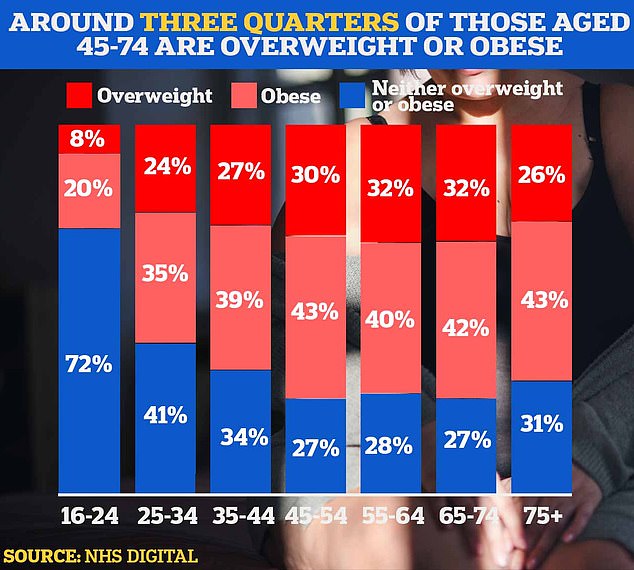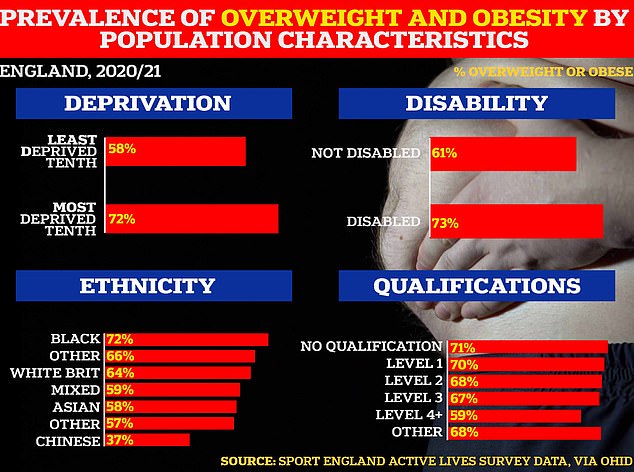England’s fattest towns REVEALED… so is YOURS one of them? Use our interactive map to find out
England's fattest boroughs are being named and shamed today.
Grim figures show that almost 40 per cent of Kingston upon Hull residents are obese.
For comparison, only a tenth of people in Kensington and Chelsea fall into the same category.
MailOnline has presented the figures in a fascinating interactive map so you can see the situation for yourself.
The Office for Health Improvement and Disparities (OHID) publishes obesity data to understand and track trends at the national and local levels.
Tackling obesity is said to be one of England's biggest long-term challenges.
On average, a quarter of adults nationwide are obese. This is classified as a BMI over 30.
After Kingston upon Hull, Barnsley has the highest prevalence of obesity (38.3 per cent), followed by South Tyneside (37.8 per cent) and Medway (37.2 per cent).
North Lincolnshire (37.1 per cent), Doncaster (36.4 per cent) and Halton (36 per cent) also top the list.
North Tyneside (35.8 percent), Blackpool (35.6 percent) and Sunderland (35.4 percent) round out the authorities where the population is largest.
However, some authorities report that only one in ten of their residents is obese.
After Kensington and Chelsea (11.6 percent), people are thinnest in Lambeth (14.2 percent), Wandsworth (14.4 percent) and Richmond upon Thames (15 percent).
In fact, all of the top 10 smallest authorities are in London.
These include Southwark (15.4 percent), Barnet (15.9 percent) and Westminster (16.3 percent), as well as Hammersmith and Fulham (16.8 percent) and Harrow (17 percent).
The proportion of Britons who are overweight or obese has grown slowly over time, reaching two-thirds in 2021, the latest available data shows. No data has been recorded for 2020, the year of the Covid pandemic

The figures are particularly higher in older population groups: only 27 percent of 45-54 year olds in England are a healthy weight

Although the nation as a whole is overweight, the rates are higher in certain groups, with Britons living in more deprived areas, having lower qualifications, being of black ethnicity or having a disability more likely to struggle with their weight
The OHID noted that obesity rates are highest among the most disadvantaged groups in society, with children in the poorest areas more than twice as likely to be obese than children in the richest areas.
Being too big can reduce life expectancy and increase the risk of heart, liver and respiratory disease.
It can also cause everyday problems such as shortness of breath, increased sweating, snoring, joint and back pain, and difficulty with physical activity.
The average woman needs about 2,000 calories per day to maintain a healthy weight, while for men it is 2,500.
Weight gain occurs when a person consumes more calories than they burn over time.
Obesity has exploded in Britain in recent years. Experts have attributed the country's ever-expanding waistline to the simultaneous rise of processed, high-calorie foods and sedentary, desk-bound lifestyles.
A shock analysis this week found that obesity now costs Britain almost £100 billion a year.
Until now, the fully reversible problem was thought to cost Britain around £60 billion.
This figure included the cost of the knock-on effects of obesity and the impact on the NHS, as well as secondary costs such as lost income due to time off work due to illness and premature deaths.
Think tank The Tony Blair Institute (TBI) funded the new analysis, which, compared to other estimates, took into account the cost of being overweight to people rather than just obesity, including economic losses and updated inflation figures.
Former government food czar Henry Dimbleby, founder of fast food chain Leon, warned the crisis risks turning Britain into a “sick and impoverished nation” and said the TBI figures represented a “disaster”.
Former Prime Minister Boris Johnson announced a 'world-leading' obesity plan in 2020, inspired in part by how his own weight had put him at greater risk of becoming seriously ill when he contracted Covid.
However, his government shunned the more radical proposals of then food czar and Leon founder Henry Dimbleby, such as taxes on salt and sugar, after calculating that the proposals could add £60 to each person's annual food bill.
The proposals that did survive – a ban on buy one, get one free deals on unhealthy snacks and junk food adverts before 9pm – have since been postponed until October 2025 by Rishi Sunak.
